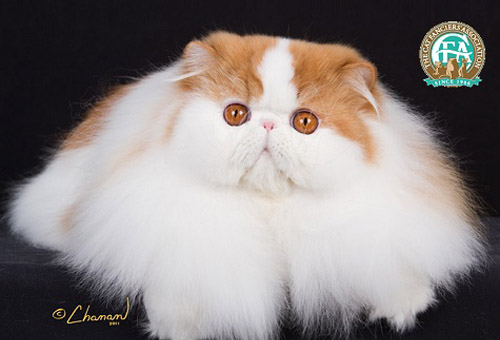

As the dusty desert caravans wound their way westward from Persia and Iran, it is supposed that secreted among the rare spices and jewels on the basket-laden camels was an even more precious cargo, an occasional longhair cat. They were called Persian for their "country of origin," but hieroglyphic references as early as 1684 B.C. shroud forever their exact beginnings.  Pictured: Best of Breed GC, BW, NW PARTI WAI HEAR ME ROAR, Red & White Persian Male Photo: © Chanan Persians, with their long flowing coats and open pansy-like faces are the number one breed in popularity. Their sweet, gentle, personalities blend into most households once they feel secure in their new environment. Creatures of habit, they are most at home in an atmosphere of security and serenity, but with love and reassurance, can easily adapt to the most boisterous of households. Their quiet, melodious voices are pleasant and non-abrasive. They communicate delightfully with their large expressive eyes and make charming pets for all ages. Persians have short heavily-boned legs to support their broad, short bodies. They like to have their feet firmly planted and are not given to high jumping and climbing. Playful but never demanding, they love to pose and will drape themselves in a favorite window or chair, enhancing the decor in much the same way as a treasured painting. Persians are tremendously responsive and become a constant source of joy and delight to their owners. Pleasurable as an unexpected sunbeam, their companionship is close and enduring. Their long flowing coats require an indoor, protected environment. Proper maintenance requires a daily run-through with a metal comb to eliminate the potential drawbacks of tangles and hairballs. An occasional bath, attempted only after a complete comb-through and clipping of the nail tips, will keep the coat clean, healthy and beautiful. It is wise to establish the routine of the bath when they are young. While the white Persian has long been the darling of photographers and advertisers, Persians come in an astonishing number of colors, which are divided into seven color divisions for purposes of competition. Those are:
Pricing on Persians usually depends on type, applicable markings and bloodlines distinguished by Grand Champion (GC), National Regional winning parentage (NW or RW) or of Distinguished Merit parentage (DM). The DM title is achieved by the dam (mother) having produced five CFA grand champion/premier (alter) or DM offspring, or sire (father) having produced fifteen CFA grand champion/premier or DM offspring. Usually breeders make kittens available between twelve and sixteen weeks of age. After twelve weeks, kittens have had their basic inoculations and developed the physical and social stability needed for a new environment, showing, or being transported by air. Keeping such a rare treasure indoors, neutering or spaying and providing acceptable surfaces (e.g. scratching posts) for the natural behavior of scratching (CFA disapproves of declawing or tendonectomy surgery) are essential elements for maintaining a healthy, long and joyful life. There are CFA clubs devoted to the promotion, protection and preservation of the Persian breed. For more information, please send inquiries to CFA at cfa@cfa.org. Text: Jeanie McPhee Last Updated: Sunday, July 04, 2010
|